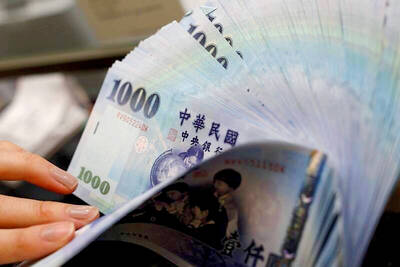The US dollar advanced against the euro and rose to a five-month high versus the yen after an industry report showed prices paid by US manufacturers jumped last month and services industries expanded at a faster pace.
The figures, one of which was accidentally released early, sparked a rally in the US currency after it initially declined following the Labor Department's monthly US payrolls report. Employers added 110,000 workers last month, barely half the number economists expected.
"A lot of players established short dollar positions at bad levels," said Tom Benfer, vice president of foreign exchange in New York at the Bank of Montreal. "As the market turned stronger for the dollar, it turned into a blood bath."
Against the euro, the dollar climbed to US$1.2912 at 5:01pm in New York, from US$1.2964 late on Thursday, according to electronic currency-trading system EBS, and rose 0.3 percent for the week.
The dollar gained to ?107.56, from ?107.15, after earlier touching ?107.79, the highest since Oct. 21. A short position is a bet on a currency's decline.
In late New York trade, the dollar stood at 1.2030 Swiss francs from SF1.1962 on Thursday.
The pound was being traded at US$1.8804 from US$1.8899 late on Thursday.
Faster growth and inflation may bolster expectations the US Federal Reserve will keep increasing interest rates to contain inflation as the US economy outpaces Europe's for a fourth year. The dollar gained 4.6 percent versus the euro last quarter, the biggest gain since the first three months of 2001.
"The very strong rise in the prices-paid number is compounding worries about inflation," said Mitul Kotecha, head of currency strategy in London at Calyon, a unit of Credit Agricole SA. "Interest rates have moved in the dollar's favor in the past few months, and it's got some catching up to do."
Japan's currency began its decline earlier on Friday in Asia after the Bank of Japan's Tankan survey showed confidence among large manufacturers unexpectedly fell in March. The yen had its third straight week of declines versus the dollar, dropping 1.1 percent.
The Institute for Supply Management said its services index rose to 63.1 from 59.8. ISM's manufacturing prices index rose to 73 from 65.5. Several news organizations, including Bloomberg News and Market News, initially published incorrect headlines for the manufacturing report after BusinessWire, a press release company, sent out ISM's separate services press release early by mistake.
"This type of thing really throws the market into a loop," said John Cholakis, a currency trader in New York at Natexis Banques Populaires. "I was caught in the middle of a trade, with stops all over, and first had to reverse my position and then get fully back into it again."
Fed policy makers raised their target rate for overnight loans between banks by a quarter-point to 2.75 percent on March 22, the seventh increase since June, and said inflation pressures are building. The European Central Bank hasn't changed its benchmark rate of 2 percent since 2003, while the Bank of Japan has held its rate near zero for four years.
Fed Bank of Chicago president Michael Moskow said inflation is increasingly a worry. Moskow, who votes on interest rates this year, said "there are some more concerns about inflation now," in an interview with CNBC television.
The dollar is up more than 5 percent from a record low of US$1.3666 per euro on Dec. 30 as the yield advantage, or spread, on US 10-year Treasury notes over German bunds of similar maturity widened to near the biggest since 2000. The gap on Friday was 88 basis points.
Investors are "placing less emphasis on payrolls figures at the moment and putting its attention on inflation and how the Fed might react," said Trevor Dinmore, vice president of foreign-exchange strategy at Deutsche Bank AG in London.
Goldman Sachs Group Inc and Merrill Lynch & Co raised their forecasts for Fed interest-rate increases because of concern inflation is accelerating, before Friday's reports were released.
Goldman, the world's third-biggest securities firm by capital, lifted its year-end forecast for the Fed's main rate to 4 percent, from 3.5 percent. Merrill, the biggest, raised its projection to 3.5 percent, from 3.25 percent.

Merida Industry Co (美利達) has seen signs of recovery in the US and European markets this year, as customers are gradually depleting their inventories, the bicycle maker told shareholders yesterday. Given robust growth in new orders at its Taiwanese factory, coupled with its subsidiaries’ improving performance, Merida said it remains confident about the bicycle market’s prospects and expects steady growth in its core business this year. CAUTION ON CHINA However, the company must handle the Chinese market with great caution, as sales of road bikes there have declined significantly, affecting its revenue and profitability, Merida said in a statement, adding that it would

MARKET LEADERSHIP: Investors are flocking to Nvidia, drawn by the company’s long-term fundamntals, dominant position in the AI sector, and pricing and margin power Two years after Nvidia Corp made history by becoming the first chipmaker to achieve a US$1 trillion market capitalization, an even more remarkable milestone is within its grasp: becoming the first company to reach US$4 trillion. After the emergence of China’s DeepSeek (深度求索) sent the stock plunging earlier this year and stoked concerns that outlays on artificial intelligence (AI) infrastructure were set to slow, Nvidia shares have rallied back to a record. The company’s biggest customers remain full steam ahead on spending, much of which is flowing to its computing systems. Microsoft Corp, Meta Platforms Inc, Amazon.com Inc and Alphabet Inc are

RISING: Strong exports, and life insurance companies’ efforts to manage currency risks indicates the NT dollar would eventually pass the 29 level, an expert said The New Taiwan dollar yesterday rallied to its strongest in three years amid inflows to the nation’s stock market and broad-based weakness in the US dollar. Exporter sales of the US currency and a repatriation of funds from local asset managers also played a role, said two traders, who asked not to be identified as they were not authorized to speak publicly. State-owned banks were seen buying the greenback yesterday, but only at a moderate scale, the traders said. The local currency gained 0.77 percent, outperforming almost all of its Asian peers, to close at NT$29.165 per US dollar in Taipei trading yesterday. The

The US overtaking China as Taiwan’s top export destination could boost industrial development and wage growth, given the US is a high-income economy, an economist said yesterday. However, Taiwan still needs to diversify its export markets due to the unpredictability of US President Donald Trump’s administration, said Chiou Jiunn-rong (邱俊榮), an economics professor at National Central University. Taiwan’s exports soared to a record US$51.74 billion last month, driven by strong demand for artificial intelligence (AI) products and continued orders, with information and communication technology (ICT) and audio/video products leading all sectors. The US reclaimed its position as Taiwan’s top export market, accounting for